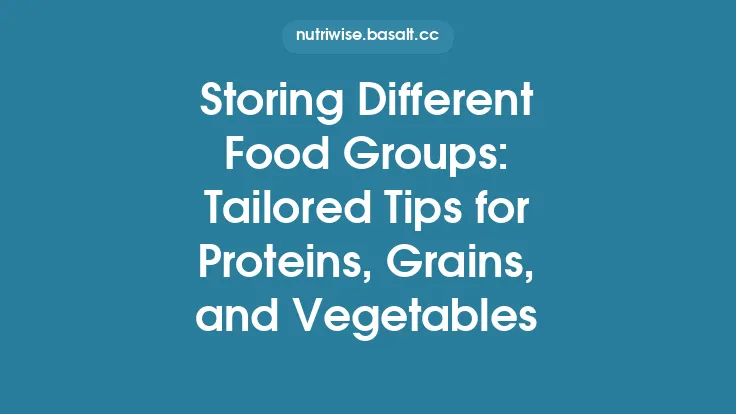When planning meals, having reliable reference points for how much of each food group to include can simplify grocery shopping, streamline cooking, and help you build nutritionally balanced plates without the need for constant weighing or guesswork. Below is a comprehensive guide to the most common servings for grains, proteins, vegetables, and fats. The information is presented in a way that can be used year after year, regardless of trends or diet fads, making it a truly evergreen resource for anyone who wants to eat well and stay organized in the kitchen.
Grains: Standard Servings and Practical Tips
What a “standard” grain serving looks like
| Food type | Typical cooked portion | Approximate weight | Calories* | Key nutrients |
|---|---|---|---|---|
| Whole‑grain rice, quinoa, barley, farro, couscous | ½ cup (120 mL) | 85 g | 150–170 | B‑vitamins, magnesium, fiber |
| Pasta (regular or whole‑wheat) | ½ cup cooked (≈ 1 cup uncooked) | 70 g | 180–200 | Iron, B‑vitamins, fiber (whole‑wheat) |
| Oats (rolled or steel‑cut) | ½ cup cooked | 125 g | 150–170 | Soluble fiber, manganese, phosphorus |
| Bread (whole‑grain, rye, sourdough) | 1 slice (≈ 30 g) | 70–80 | 70–90 | Fiber, selenium, B‑vitamins |
| Tortilla (corn or whole‑wheat) | 1 medium (≈ 30 cm) | 45 g | 100–120 | Magnesium, iron |
\*Calorie values are averages; exact numbers vary by brand and preparation method.
Why the ½‑cup benchmark?
Cooking grains typically expands them 2–3 times their dry volume, so a ½‑cup of cooked grain provides a consistent amount of carbohydrate and fiber across a wide variety of grains. This makes it a reliable building block for meal planning.
Cooking yields to keep in mind
| Dry amount | Expected cooked volume | Approx. weight after cooking |
|---|---|---|
| ¼ cup dry rice | ¾ cup cooked | 150 g |
| ¼ cup dry quinoa | ¾ cup cooked | 140 g |
| ¼ cup dry pasta | ½ cup cooked | 115 g |
| ¼ cup dry oats | ½ cup cooked | 120 g |
Knowing these yields lets you batch‑cook a larger quantity and portion it out later without having to re‑measure each time.
Practical storage tip
Store cooked grains in airtight containers in the refrigerator for up to 4 days, or freeze in ½‑cup portions for up to 3 months. Label each container with the date and type of grain; this eliminates the “guess‑what’s in the fridge” dilemma.
Proteins: Defining a Serving Across Sources
Standard protein serving
| Source | Typical serving size (cooked) | Approx. weight | Calories* | Primary macronutrient profile |
|---|---|---|---|---|
| Skinless poultry (chicken, turkey) | 3 oz (≈ 85 g) | 85 g | 140–160 | ~30 g protein, <5 g fat |
| Lean red meat (beef, pork, lamb) | 3 oz (≈ 85 g) | 85 g | 170–190 | ~22 g protein, 7–10 g fat |
| Fish (salmon, cod, tuna) | 3 oz (≈ 85 g) | 85 g | 120–180 | 20–25 g protein, 2–10 g fat (higher in oily fish) |
| Plant‑based legumes (lentils, beans, chickpeas) | ½ cup cooked | 100 g | 110–130 | 7–9 g protein, 0.5–1 g fat, 7–9 g fiber |
| Tofu (firm) | ¼ cup (≈ 60 g) | 60 g | 50–60 | 5–6 g protein, 3 g fat |
| Tempeh | ¼ cup (≈ 55 g) | 55 g | 100–110 | 10 g protein, 5 g fat |
| Eggs | 1 large egg | 50 g | 70–80 | 6 g protein, 5 g fat |
| Greek yogurt (plain, 2 % fat) | ¾ cup (≈ 170 g) | 170 g | 100–120 | 12–15 g protein, 2–3 g fat |
\*Calorie values are averages; cooking method (grilling, sautéing, baking) can add or subtract a few calories.
Key considerations when choosing protein servings
- Amino acid completeness – Animal proteins are naturally complete, containing all nine essential amino acids. Most plant proteins are incomplete, but combining legumes with grains (e.g., rice and beans) within the same day provides a complete profile.
- Fat content variation – Lean cuts of meat and skinless poultry are low in fat, while oily fish and certain plant proteins (tofu, tempeh) contain higher amounts of healthy unsaturated fats.
- Cooking loss – High‑heat methods (grilling, broiling) can cause a 10–15 % loss of moisture, slightly concentrating protein per gram. Conversely, simmering or poaching retains more water, making the final weight higher but the protein content per gram lower.
Batch‑cooking guidance
- Meat & poultry: Roast a whole chicken or a large beef roast, then carve into 3‑oz portions. Freeze in zip‑top bags with a label indicating the date and cooking method.
- Legumes: Cook a large pot of dry beans (1 cup dry → ~6 cups cooked). Portion into ½‑cup servings and freeze.
- Tofu/Tempeh: Press tofu to remove excess water, then cut into ¼‑cup cubes. Marinate and bake; store in airtight containers for up to 5 days.
Vegetables: Volume‑Based Servings and Variety
Standard vegetable serving
| Category | Typical serving size (raw) | Approx. weight | Calories* | Notable nutrients |
|---|---|---|---|---|
| Leafy greens (spinach, kale, lettuce) | 1 cup loosely packed | 30–40 g | 5–10 | Vitamin K, A, folate |
| Cruciferous (broccoli, cauliflower) | ½ cup florets | 45 g | 15–20 | Vitamin C, fiber, glucosinolates |
| Starchy veg (potato, sweet potato, corn) | ½ cup cooked | 75–90 g | 70–100 | Potassium, vitamin C, complex carbs |
| Other non‑starchy veg (peppers, carrots, zucchini) | ½ cup cooked or raw | 60–70 g | 15–30 | Beta‑carotene, vitamin C, fiber |
| Legume‑based veg (edamame) | ½ cup shelled | 80 g | 100–110 | Protein, iron, folate |
\*Calorie values are averages; raw vs cooked can shift numbers slightly due to water loss.
Why volume matters
Vegetables are low in calories but high in water and fiber, so measuring by cup or by the handful provides a realistic sense of how much you’ll actually eat. This approach also aligns with the “fill half your plate with veg” visual cue without turning it into a strict portion‑control rule.
Cooking considerations
- Water‑soluble nutrients (vitamin C, B‑vitamins) can leach into cooking water. To preserve them, steam or sauté rather than boil, or reuse the cooking liquid in soups or sauces.
- Texture changes – Starchy vegetables become denser when roasted, so a ½‑cup roasted sweet potato may weigh slightly more than the same volume boiled. Adjust based on the desired mouthfeel.
- Batch roasting – Spread a mix of non‑starchy veg on a sheet pan, toss with a small amount of oil (see the “Fats” section), and roast at 200 °C (400 °F) for 20–30 minutes. Portion into ½‑cup containers for quick reheating.
Seasonal variety tip
Rotate the vegetables you purchase each season. This not only keeps meals interesting but also ensures a broader spectrum of phytonutrients. Keep a simple log (e.g., “Spring: asparagus, peas, radish”) to remind yourself of what’s in season and to guide grocery lists.
Fats: Measuring and Using Healthy Fats
Standard fat serving
| Fat source | Typical serving size | Approx. weight | Calories* | Dominant fatty acids |
|---|---|---|---|---|
| Olive oil (extra‑virgin) | 1 tsp (5 mL) | 4.5 g | 40 | Monounsaturated (oleic) |
| Butter | 1 tsp (5 g) | 5 g | 35 | Saturated (palmitic) |
| Avocado | ¼ medium fruit | 30 g | 50 | Monounsaturated, fiber |
| Nuts (almonds, walnuts) | ¼ cup (≈ 30 g) | 30 g | 170–190 | Poly‑ and monounsaturated |
| Seeds (chia, flax) | 1 tbsp (≈ 10 g) | 10 g | 55–60 | Omega‑3 (ALA) |
| Nut butter (peanut, almond) | 1 tbsp (≈ 16 g) | 16 g | 95–100 | Monounsaturated, some saturated |
| Coconut oil | 1 tsp (5 mL) | 4.5 g | 40 | Saturated (medium‑chain) |
\*Calorie values are averages; exact numbers depend on brand and processing.
How to gauge a fat serving without a scale
- Oil: A standard teaspoon is roughly the size of the tip of your index finger from the first knuckle to the tip.
- Butter: One tablespoon (the amount that fits into a standard butter dish) equals three teaspoons.
- Nuts & seeds: A small handful (about the size of a golf ball) approximates ¼ cup.
- Avocado: Cut the fruit in half; each half is roughly ½ cup. One quarter of a half (i.e., a slice that is about a quarter of the whole fruit) equals the ¼‑fruit serving.
Integrating fats into meals
- Cooking medium – Use 1 tsp oil per ½ cup of vegetables when sautéing. This provides flavor and prevents sticking while staying within a modest fat budget.
- Finishing touch – Drizzle ½ tsp of olive oil over a cooked grain or salad just before serving for added mouthfeel and to aid absorption of fat‑soluble vitamins (A, D, E, K).
- Texture enhancer – Add ¼ cup nuts or seeds to grain bowls, yogurt, or oatmeal for crunch and a boost of essential fatty acids.
Storage pointers
- Oils: Keep in a cool, dark cabinet; use within 6 months of opening.
- Nuts & seeds: Store in airtight containers in the refrigerator to prevent rancidity; they stay fresh for up to a year.
- Nut butters: Stir before using; the natural oil may separate. Refrigerate after opening to extend shelf life.
Putting It All Together: Building a Balanced Meal
While the focus here is on serving guides, it is useful to see how the four groups can be combined into a cohesive plate:
| Component | Typical serving (per adult) | Example combination |
|---|---|---|
| Grains | ½ cup cooked | ½ cup quinoa |
| Protein | 3 oz cooked meat or ½ cup cooked legumes | 3 oz grilled chicken |
| Vegetables | 1 cup total (½ cup leafy + ½ cup other) | ½ cup roasted broccoli + ½ cup mixed greens |
| Fats | 1 tsp oil or ¼ cup nuts | 1 tsp olive oil used for roasting + ¼ cup toasted almonds sprinkled on top |
A single meal built around these quantities typically provides:
- Calories: 400–600 kcal (depending on fat choice)
- Protein: 20–30 g
- Carbohydrates: 40–55 g (mostly complex, high‑fiber)
- Fat: 10–20 g (predominantly unsaturated)
These macro ranges align with general dietary recommendations for a balanced diet, yet the guide does not prescribe a “diet plan” or weight‑loss strategy—its purpose is to give you a repeatable, evidence‑based framework for everyday cooking.
Storing and Repurposing Common Servings
Batch‑cook and portion – Cook a large pot of grains (e.g., 4 cups cooked quinoa) and divide into ½‑cup containers. Pair each with a pre‑measured protein (3 oz chicken, ½ cup lentils) and a frozen vegetable mix (½ cup). This “grab‑and‑go” system reduces daily decision fatigue.
Freezer‑friendly combos
| Meal type | Recommended freezer portion | Thawing method |
|---|---|---|
| Stir‑fry kits | ½ cup cooked rice + 3 oz protein + 1 cup mixed veg | Microwave 2–3 min, stir |
| Soup bases | ½ cup cooked beans + ½ cup diced veg + 1 tsp oil | Add broth, simmer 10 min |
| Casserole layers | ½ cup cooked pasta + 3 oz ground turkey + ½ cup sauce + 1 tsp butter | Bake at 180 °C (350 °F) 20 min |
Label each package with the date, component list, and any seasoning notes. This practice eliminates the “guess‑what’s in the freezer” moment and ensures food safety.
Re‑using leftovers
- Grains: Turn leftover quinoa into a cold salad by adding chopped veg, a drizzle of oil, and a squeeze of lemon.
- Proteins: Shred cooked chicken and mix with Greek yogurt and herbs for a quick sandwich spread.
- Vegetables: Blend roasted veg with broth for a creamy soup; the added oil from roasting contributes to a richer mouthfeel.
- Fats: Use leftover nut butter as a base for a homemade sauce (mix with soy sauce, ginger, and a splash of water).
By anchoring your kitchen routine to these clear, quantifiable serving guides, you can streamline grocery lists, reduce food waste, and consistently assemble meals that are nutritionally sound. The information presented here is designed to remain relevant regardless of culinary trends, making it a reliable reference for years to come.





